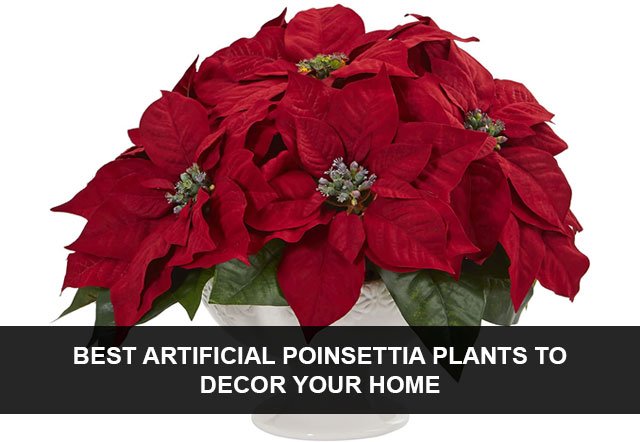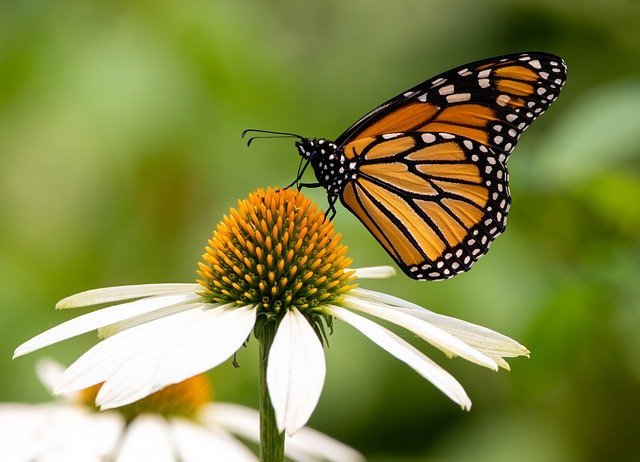Thinking about Asian indoor plants to decorate your interior? Well, you are in the right place to select some of the amazing Asian houseplants for making your home look more dashing.
Asia is one of the largest continents in the world in which you can find the world’s most diverse species of plants. From these species, there are some beautiful houseplants derived which can be used indoors to add some beautiful blooming color to your indoors.
Why You Should Care About Indoor Asian Plants?
Asian indoor plants provide many health benefits, and we can use them in many different decorations in our homes. You should grow these plants because it invigorates your home and when some guests come into your home, they also feel fresh and welcoming. So, try to grow different and beautiful species of Asian plants in your indoors to make a happy, blooming environment for your indoors.
Furthermore, Asian plant species require proper care if you want to grow them in your indoors. Although you can place it on your desktop tables, stairs, hallways, side tables and wherever you feel like to fill the free space in your indoors.
The most important factor in growing Asian indoor plants is that you should select those species of Asian plants which have a good root system because it is very important for any indoor plant to have a good root system.
Well, growing Asian plants in your indoors is not an easy task. You have to use some fertilizers to draw away pests and other insects from making a supper out of your plant.
Here are some Asian indoor plants to furnish your home interior with a blooming green color.
1. Money plant
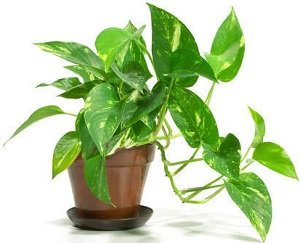
Botanical name: Epipremnum Aureum
The money plant is one of the most popular Asian indoor plants that you can place in your indoors as this plant is also known for bringing luck and prosperity to your house. You can place it on your desktop tables, side tables and so on. If you look at this beautiful plant deeply, then you will see an amazing array of green colors with splashing white. This plant has heart-shaped leaves with white stripes on it that look like a coin, so this is the main reason why this plant is called a money plant.
However, this plant also has some health benefits as it helps to remove formaldehyde from the atmosphere. If you are living in a city where air pollution affects your health, then you should plant money trees in your homes to get fresh and healthy air. Anyone that has an asthma issue or lung issue should grow this plant to maintain freshness in its home environment.
Important facts to care Money Plant
- Soil type
Money plants love to grow in those soils which are well-drained. You can mix some river sand with any potting soil because these plants like to grow in a such mixture of soil so that they can grow fast and produce glooming green shades. Pearlite content soils are the second option to grow your money plant in them.
- Watering of Money Plant
Well, the watering of money plants depends on the weather conditions around your region, but the interesting fact is that you don’t need to worry about watering these plants because these types of plants don’t need much water to grow.
In the winter season, money plants need water after 2 to 3 weeks because this plant absorbs much moisture from the air in winters but on the other hand, in summers, you should water these plants after 5 to 7 days. You just have to make sure that the soil of the money plant will not completely dry up because it can drastically affect the growth of this plant.
- Need of Sunlight
Money plants need sunlight to grow properly. If you are growing this plant in your indoors, then you should probably place it near the window from where most of the sunlight falls in your home. You can also place it under some partially shady area. You must know that these plants mostly prefer low shades of sunlight but if you want to place them under direct sunlight, make sure that they will not get direct flaming rays because these rays can burn the leaves of this plant and can damage the growth of money pant.
- Fertilization
Well, you need to add fertilizers to your money plant but in some cases, you have to use them. If your money plant didn’t grow healthily and starts drying after a while, then you should use fertilizers to give strength to the soil. You can use water fertilizers or sand fertilizers to get healthy, wealthy Asian plants in your indoors. Just make sure that you feed fertilizers to plants in the evening time because it is the best time to fertilize your plant.
- Planting options for Money plants
Most of us are familiar with this process that you can grow money plants in water tanks or water bottles. To get good and quick results, keep the roots of the money plant under water and place it in an area where it gets some sunlight.
After 2 to 3 days, you have to change the water in the tank and bottle so that the plant inhales fresh water after every 3 days. The most interesting thing is that if you are growing this Asian indoor plant in water, then you don’t have to add fertilizers to it.
2. Areca Palm

Botanical name: Dypsis Lutescens
Areca Palm is one of the most amazing Asian indoor plants that is being widely used to enhance the interior of homes. It has a beautiful array of long feathery fronds that attracts your attention to this plant. This areca palm plant helps to add a fresh ambience to your home as it can absorb harmful gases in your interior to give you a heartful and healthy vibe in your homes.
Furthermore, these plants required low maintenance. You can easily grow these plants in your indoors. You can place it anywhere in your home as these houseplants need low-maintained sunlight. However, other types of palm plants have some toxin issues but if you grow areca palm, it doesn’t contain any toxins in it and your pets will remain safe if they, unfortunately, eat this plant.
Important facts to care Areca Palm
- Soil type
These Asian indoor plants can grow in a well-drained potting mixture as these plants love to grow in a potting mixture which remains moist for a longer period. It doesn’t mean that the Areca palm soil mixture should remain moist all the time. A moderate level of moisture on the potting mixture is best for this plant to grow healthily.
- Watering of Areca Palm
This Asian indoor plant is from the land of Madagascar which is quite a warm place. Well, the areca palm likes to grow in moist soil. This points a finger to the important point that you should water these plants twice a day because if their soil remains moist then this plant grows very fast, especially in their growing seasons like summers and springs.
In their growing season, it consumes all the nutrients very fast and if you un-intentionally break the chain of nutrients by not giving them water, then your Areca Palm will probably become dull or even die.
- Exposure of Sunlight
This Asian indoor plant likes indirect exposure to sunlight as it helps to grow healthy blooming green leaves. If your Areca Palm doesn’t get sunlight, it is a chance that its leaves become dull and dry and start to wrinkle.
If you have placed your areca plant under direct sunlight, then remove it instantly from such a place because the direct rays of sunlight can burn the leaves of the areca. Unfortunately, if this plant gets sunburned, then you have to dispose of the dead leaves because there is no alternate option to recover them.
- Use of fertilizers
As we know that this plant grows quickly in the summer and spring seasons, you can use fertilizers in its growing season to give the areca plant a boost in healthy growth. You can add fertilizers to your areca after one month. This Asian indoor plant likes liquid fertilizers because in their growing season, these plants absorb more nutrients and water and if you use liquid fertilizers, then they are able to absorb the nutrient of fertilizer more smoothly and quickly.
- Toxicity
Well, this plant is not toxic to your pets whether it is a cat or dog. You can safely place it in your indoors if you have any pets in your home.
3. Spider plant
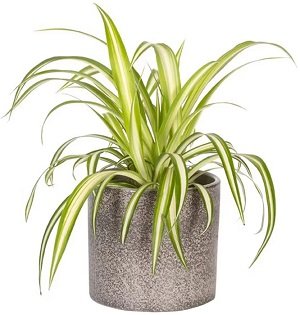
Botanical name: Chlorophytum Comosum
The spider plant is one of the most beautiful Asian indoor plants that look like mini overflowing water. It has a beautiful array of colors on the leaves and symbolizes your interior with its beautiful refreshing appearance. However, you can easily grow this houseplant in your indoors.
Furthermore, this houseplant looks beautiful in hanging baskets or hanging pots. They can purify your indoor atmosphere and they are non-toxic to your pets. The spider plant is a classic choice to add to your interior.
This Asian indoor houseplant has long leaves with mostly green or white strips on it. If you place it on your desktop table or side table, make sure anyone will not crush the long leaves of this plant.
Important facts to care Spider Plant
- Soil type
The spider plants can survive on any type of soil but mostly, it prefers moist and loamy soil that has a good drainage system. If the soil of your spider plant contains salt, then the leaves of the plant will change their shades to brown.
- Watering of spider plant
The spider plants like to grow in moist soil, but it doesn’t mean that you overwater this plant. The overwatering of spider plants can cause roots to rot and make your plant’s appearance look dull and dead. As water contains fluoride and chlorine from which plants remain sensitive because these nutrients in hose water can change the color of the leaves of this plant into brown. So, I will recommend that you use distilled or rainwater.
- Exposure of sunlight
This plant like to get indirect sunlight to grow healthily in your indoors. You can place it near your home windows, desktop tables, side tables, balconies or in any free space in your house. If you place this houseplant under direct sunlight, then the leaves of the spider plant will start burning which may lead to its death .
- Use of fertilizer
During the growing seasons of the spider plant, you can use moderate-level fertilizers in this plant. In spring and summer, you should use fertilizers after 1 month to get a healthy growth of your plant. If you try to add too much fertilizer to spider plants, then the leaves of the plant turn brown. So, don’t overuse fertilizers because excess of everything is bad. You can use water-soluble fertilizer for your spider plant but read the instructions carefully about how to use water-soluble fertilizer in a spider plant and add the fertilizer accordingly.
- Humidity and temperature
For spider plants, warm and humid conditions are the best ideal conditions for these plants. These indoor houseplants don’t grow well in cool conditions. They like the temperature above 50 degrees Fahrenheit. You can get the idea that you should moderate the temperature of your indoors according to this condition.
4. Inch plant

Botanical name: Tradescantia Zebrine
If you are looking for beautiful Asian indoor houseplants to decorate and add vibrant color to your indoors, then you should try to add an inch plant to your home decor. These houseplants look amazing in hanging baskets, doorsteps, side tables or on the top of your dining table.
The inch plant is also known as one of the easiest plants that you can take care of indoors because it is a carefree plant. It can grow rapidly in any condition and bless indoors with its refreshment. You should know first that these plants don’t last for a long time and after some years, you have to replace them. if you collect cuttings of this plant and propagate them to other pots, then you can hold this plant for quite a long period.
The inch plant has a beautiful mixture of purple and silver-striped foliage that spreads its amazing foliage in your indoors. This plant knows how to survive at indoor room temperature and behaves itself accordingly.
Important facts to care Inch plant
- Soil type
The Inch plant loves to grow in nutrient-rich soil which remains moist for long period but drains water efficiently. Before selecting soil, you should first make sure that there is plenty of organic matter in the soil because it helps to grow plants rapidly.
- Watering of inch plant
As we know that this plant likes moist soil, you should keep the soil moist by watering it regularly. If the visible soil from the upper side of the plant starts to dry, then add some water to keep it moist. Don’t overflow water in this plant because it can cause roots to rot and eventually, your inch plant starts to get dull or dead.
- Exposure of sunlight
The inch plant can handle any light conditions, but it prefers bright indirect sunlight. You can place it near your windows so that these plants get some indirect sunlight. On the other hand, exposure to direct sunlight can damage the leaves and purple foliage of the plant.
- Use of fertilizer
Well, you will find it interesting that this houseplant doesn’t require any fertilization but if you want to prevent them from pests or bad bugs, then you can use water-soluble fertilizers. During the growing season, you can use fertilizers to promote the healthy growth of inch plants.
- Humidity and temperature
The inch plant can bare room temperature because it is one of the best houseplants that can grow vigorously in your indoors. Just make sure the room temperature should remain between 50 to 80 degrees Fahrenheit.
Furthermore, inch plants mostly like an extra humid environment. You can place it in your kitchens or bathrooms to give it a high degree of humid environment. To check the humidity need, you should check the tips of the leaves if they start to dry out or turn brown, then increase the humidity level.
5. Bamboo plants

Botanical name: Bambusoideae
Bamboo plants are known to bring luck, prosperity, charm and freshness to your indoor environment. Mostly, it is believed that bamboo plants bring good luck, wealth and happiness if you place them in your offices or homes. As we know that bamboo plants grow very aggressively and due to this reason, there is some modification made by different peoples for keeping this houseplant in your indoors.
Today, you will easily find bamboo plants in different shapes and sizes. Well, this plant can brighten your interior with its freshness and fills up the space in your home. It helps to create more fresh and healthy oxygen in your indoors.
However, bamboo is the easiest houseplant that can grow rapidly in your indoors. Well, if you don’t have much time to care for your indoor plants, then you should plant bamboo because this plant needs no attention to grow abundantly in your indoors.
Important facts to care Bamboo plants
- Soil type
Lucky bamboo thrives in both water and soil. You can use any type of potting soil to grow bamboo plants because these plants are one of the most fast-growing plants in the world. In soil, your bamboo will live for quite a long period but on the other hand, if you propagate it in water, then you will need to look after the water , care for it more frequently as compared to soil growing bamboo.
- Watering of bamboo
If you are growing your bamboo in soil, just make sure the soil remains damp because these plants like to grow in moist soil but don’t overflow the water bearer as it can cause root rot. Bamboo plants don’t need much water to grow. The interesting thing is that you can also grow this plant in water. If you want to grow bamboo in water, then make sure the roots of bamboo remain underwater and renew the water after at least 8 to 10 days.
- Exposure of sunlight
Luck and Prosperity bringer bamboo needs moderate or indirect exposure to sunlight because if you place this plant under direct exposure to sunlight, then the edges of the leaves will start to turn brown like they are burned by fire.
- Temperature and humidity
Bamboo plants are one of the best Asian indoor plants that you can easily place in your offices or homes because they can bare room temperature between 18 to 35 degrees C but in winters, you should drag them away from your doors and windows because it becomes difficult for them to survive in cold weather conditions.
- Toxicity
This houseplant is harmful to cats and dogs but not to humans. So, try to keep this plant away from the range of your pets. It can cause vomiting, weakness and even abdominal pain to your pets if they eat this houseplant.
6. Prayer plant

Botanical name: Maranta Leuconeura
This Asian indoor plant comes from South America that has a unique pattern of brown and dark green rows on it. This low-maintenance Asian plant is well-known for its flat leaves which fold up to appear as hands in the prayer position. Due to this reason, we call this houseplant a prayer plant.
The tri-color pattern foliage makes it one of the most attractive houseplants that you can place anywhere in your home to add a little flavor and life to your indoors. There are several health benefits of prayer plant as it helps to clean the air as it purifies the air of your indoors and adds a degree of liveliness which becomes quite appealing to your home interior.
The prayer plant needs special care to thrive as this plant is not for those, who need or prefer a low-maintenance plant. This beautiful specie of plant rewards you if you completely take care of it.
Important facts to care Prayer plant
- Soil type
Well, prayer plants go well with simple potting soil, but you just have to make sure that it drains well because if it doesn’t drain the water, then it can cause root rot and affects the growth of a plant. You can use peat-free soil in which you can add some loam soil and perlite soil to get quick and healthy growth of the prayer plant.
- Watering of prayer plant
Watering schedules can cause some issues for you as you have to water them regularly. Don’t let the soil completely dry out because it can cause some bad effects on your houseplant. The trick to caring for a prayer plant is to never dry out the upper layer of the plant. Simply, add water if you see any dryness on the soil because this plant likes to grow in moist soil but don’t overwater it as it can cause paleness of color in leaves or even fall of leaves. So, check your prayer plant after 5 to 7 days and keep them happy.
- Exposure of sunlight
Without adequate exposure to sunlight, this plant won’t be able to grow to its full potential. You will soon , see dull or dead plant if it doesn’t get adequate light. The prayer plant needs bright, indirect sunlight to spread its beautiful colors and foliage in your indoors. You can place it near the windows of your home so that it can get shaded sunlight from the window.
- Use of fertilizer
During the growing season of prayer plants, they need some fertilizers to speed up the growth as they require more nutrients to grow healthily. So, if you add some water-soluble fertilizers to the soil, then these plants will thrive more quickly and create a fresh and blooming environment for your indoors. In the spring season, add fertilizer after every 2 weeks and in the winter season, add fertilizer after 1 month.
- Humidity and temperature
The prayer plants love to grow in high humidity and high temperature. Providing the proper humidity and temperature to prayer plants can be hard and challenging especially in winter because the temperature of your homes fluctuates in winter. So, try to provide moderate room temperature to your prayer-plants to get the glooming beauty of different foliage colors.
- Toxicity
This houseplant is non-toxic to humans or pets. So, grow them in your indoors and make a fresh and happy environment.
7. Jade plant

Botanical name: Crassula Ovata
The Jade plant is one of the popular Asian houseplants that have chubby, oval-shaped leaves and hard wooden stems which look like a small tree trunk. This houseplant can grow up to 5 inches in height, but the growing speed is very slow as it gains only 2-inches’ height in 1 year.
In many Asian cultures, it has been observed that the jade plant signifies luck and prosperity. Most people in Asia place it in front of their doors to welcome money. Jade plants can adapt to the atmosphere of your home and can easily survive in your home because it is one of the best houseplants to grow in your indoors.
Jade plants can be grown both indoors and outdoors in hot conditions. Your houseplant will get more nutrients if you place it outdoors during the summer season. At the night, if the temperature falls to 50 F, then bring them back inside the home and place them anywhere.
Important facts to care Jade plant
- Soil type
Jade plants can tolerate rocky or sandy soil, but the soil should be well-drained to prevent the roots of the plant to get rot. This plant likes to grow in slightly acidic PH soil that should drain well to prevent the plant from having fungal growth. If you are facing difficulty in drainage, you can use perlite soil to increase drainage.
- Watering of Jade plant
In the summer and spring seasons, water your jade plant regularly because, in these seasons, the plant increases its growth rate which requires more nutrients so that your jade plant can grow healthily. In the winter season, you should water your jade plant once a month because your plant gets moisture from the atmosphere, so they don’t require additional water.
- Exposure of sunlight
Jade plant likes to be in sunlight but direct exposure to sunlight can scorch the leaves of plants, especially young plants can be affected by direct sunlight. So, try to place it under some shady area so that the young leaves will not burn and grow healthily. Well, a south-facing window is an ideal position to place your jade plant.
- Use of fertilizers
During their growing season, many people didn’t feed their plants properly, so you have to use some fertilizers to feed succulents during their growth time. However, to overcome the need for more nutrients in their growing season, you should use water-soluble fertilizers. After every week, you have to add fertilizer to the jade plant if you want a healthy growth from your houseplant.
- Humidity and temperature
This Asian plant prefers room temperature ranging from 60 to 80 degrees Fahrenheit. During the nighttime, these plants can bare a temperature under 50 degrees F. So, don’t place your plant where the temperature thrives below 50-degree F. In winter, your home temperature remains moderate, so if you have placed your jade plant on your window, then place it elsewhere to protect it from cold.
- Toxicity
Jade plants are highly toxic to dogs and cats, so make sure to place this plant away from the range of your pets. Humans can also get irritation or allergy to their skin, hence, always be careful while dealing with this particular houseplant.
8. Cast iron plant

Botanical name: Aspidistra Elatior
The cast iron plant commonly known as the iron plant is one of the hardy houseplants that is mostly grown by those people who don’t have much time to care for plants properly. This specie of plant can survive the hardest conditions whereas most of the other plants are not able to survive those conditions and eventually die.
Furthermore, if you want to grow this Asian indoor plant in your home, then you can easily grow them and place them in any suitable place in your indoors. The leaves of this plant are 2 to 4 inches long and have a laced-shaped appearance, deep green in color and gloom in the bright light.
The most interesting thing about the cast iron plant is that it produces purple flowers on the base of the soil which blooms the appearance of the cast iron plant.
Important facts to care cast iron plant
- Soil type
Cast iron plants can go through any type of soil but the soil should drain well. Mostly, the iron plant prefers soil which is rich with organic material and has an acidic PH of soil.
- Watering of cast iron plant
Well, cast iron plants love to grow in little moist soil. however, you don’t have to compile it with soggy soil because they don’t like to grow in soggy soil. if you overwater this plant, it can cause root rot. So, to prevent root rot, you should water them once in 1 week. To check whether your plant needs water or not, you should stick your finger on the top layer or soil and if you feel the soil is moist, then don’t water it but if you feel nothing, then you should pour some water in it.
- Exposure of sunlight
My advice is to keep your Asian cast iron plant away from direct contact with sunlight because full exposure to sunlight can bleach or burn the leaves of iron plants. The ideal location for placing your Asian plan is the north face window of your home but try to keep it a little bit away from the window.
- Use of fertilizer
You can use all-purpose water-soluble fertilizer once a month to keep them fresh and healthy. During the summer and spring seasons, cast iron plants need more nutrients so by using fertilizers, you can provide nutrients to this house plant.
- Humidity and temperature
This Asian houseplant doesn’t fuss too much about the level of humidity around them because they can adapt to any conditions. If we talk about temperature, they can grow well at room temperature and adapt themselves accordingly. The least temperature that can be bared by this plant is above 50 degrees Fahrenheit.
9. Aloe Vera plant

Botanical name: Aloes
Aloe Vera is one of the most popular houseplants that has many benefits in our daily use. This plant is also popular from the name medicinal plant which can heal wounds, eases irritation and soften your skin. This is a reason why so many people want to plant it in their homes.
This Asian plant has laced-shaped leaves with spiky edges. Well, sometimes, you will see a spiky flower on the end of a stalk of the Aloe Vera plant. Getting flower stalks from this plant is not an easy task because only mature Aloe plants can produce such beautiful flowers. If you take good care of this plant, then after 3 to 4 years, it can produce yellow, red or orange flowers.
Important facts to care Aloe Vera plant
- Soil type
Aloe Vera plants love to grow in sandy soil or cactus soil which will drain well. The traditional potting soil is also a good medium to grow this plant as they like to grow in those soils which are poor in nutrients. Well, you can use acidic soil as well to grow this beautiful house plant and add some perlite or coarse sand to it. This will make a mixture of perfect soil in which this plant loves to grow.
- Exposure of sunlight
This plant loves to thrive in bright exposure to sunlight. At Indoors, place it in front of the window so that it can get bright shaded sunlight. As we know that this plant has tender skin which can burn if they are under contact with direct sunlight for more than 8 hrs. So, with keeping that in mind, place it where this plant gets only 6 hours’ exposure to sunlight.
- Watering of Aloe Vera
Aloe plants like to grow in moist conditions as this plant prefers to be watered after regular intervals of time. However, if the soil of this Asian indoor houseplant remains dry for a long period, then the leaves of Aloe can dehydrate or dry up and eventually, they will die. So, water this plant regularly after 1 to 2 days.
- Use of fertilizer
As mentioned above, Aloe are able to grow in poor soil conditions because it can adapt itself to harsh conditions and doesn’t allow you to use fertilizers. If you want to use fertilizer in Aloe, you can use water-soluble fertilizer once a whole year during the spring season otherwise, you don’t have to use any kind of fertilizer.
- Humidity and temperature
Aloe is a naturally growing plant that can bear any type of weather conditions. This houseplant can thrive at room temperature, and you can place it everywhere in your indoors. The humidity factor doesn’t affect it much because they can adapt to any weather conditions.
- Toxicity
Well, this plant can cause vomiting or some serious problems if you try to eat them. So, don’t eat them, only use them for your skin treatment. The leaves of Aloe are also toxic to your pets, try to place your Aloe plants away from the reach of your dogs and cats.
10. Boston Fern
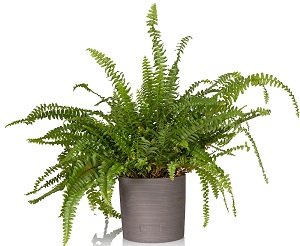
Botanical name: Nephrolepis Exaltata
Boston fern is one of the popular fern specie that you can grow as a houseplant in your indoors. It is also known by the name ‘sword fern’ which is loved by most gardening people. This plant has its unique class and displays the beautiful tiny petals of leaves that can glow your interior and add freshness to your home. This Asian houseplant is originally from north America which doesn’t require a lot of sun exposure and doesn’t require any care.
It has beautiful green-blue foliage which makes it different from other Asian indoor houseplants. If you have any experience to grow fern specie, you probably know that they grow at a very steady rate, so you have to be patient while growing Boston fern.
Important facts to care Boston fern
- Soil type
Boston fern plants like moist, loamy soil to grow but the soil should have a good drainage system. You can use peat-based potting soil with perlite to increase the drainage system of Boston fern. If you don’t use well-drained soil, it can cause root rot and ultimately, kill this beautiful specie of fern plan.
- Watering of Boston fern
This Asian plant likes to grow in moist soil as mentioned above, so pour water regularly into the Boston fern container so that your plant can feel fresh and bloom in your inner house with its awe-inspiring fragrance. In winter, don’t water the plant regularly because it is getting nutrients from the atmosphere. If you add water in winter, it can cause root rot.
- Exposure of sunlight
This Asian plant does its best when you place it under shady exposure to sunlight. For porch plants, the Boston fern is the best choice that will receive shady sunlight during the day and nighttime.
- Use of fertilizer
As we know the Boston fern is a slow feeder which doesn’t mean that this plant thrives in diverse soil conditions. You have to use some type of fertilizer to maintain the growth of the houseplant. You can add water-soluble fertilizer during the summer and spring seasons as in that period as they need more nutrients to grow.
- Humidity and temperature
Boston fern plants can survive between 65 to 80 degrees Fahrenheit. This Asian plant loves to grow in moderate weather conditions where they get less exposure to sunlight in summers and in winters, they get low coldness. If we look at the humidity level, it needs above 80% humidity level to thrive.
- Toxicity
According to the research of ASPCA, the Boston fern plants are non-toxic to cats and dogs. So, you can place it in your homes wherever you want.
Conclusion
In the end, I just want to say that if you are planning to grow Asian plants in your indoors, then select such plant which is non-toxic to humans or if you have any pet in your home like a dog or cat, try to place it away from their reach otherwise, your pets can eat the plants and get sick. You can get some help from my article to select the ideal Asian plant for your home.
I hope this ultimate guide to indoor Asian plant helped you to select the right Asian houseplant and your house can glow with its freshness.



